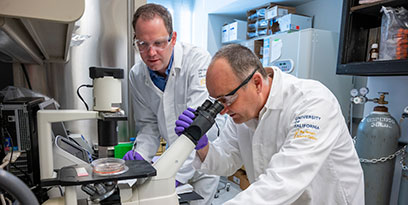David Segal, Ph.D.

Professor
4512 Genome Building
Davis Campus
Ph: 530-754-9134
djsegal@health.ucdavis.edu
Lab Website
Research Interests
Zinc finger, TALE, CRISPR/Cas genome engineering and targeted gene regulation for applications in research and therapeutics, especially neurologic disorders.
Research Synopsis
- Molecular therapy for neurologic genetic diseases
Together with the labs of Kyle Fink and Jill Silverman, we are developing molecular therapies for neurologic disorders. We use programable DNA- or RNA-binding platforms (Zinc finger, TALE, CRISPR/Cas9, Cas12, Cas13) to cause long-term changes in the expression of disease genes. This approach avoids problematic double-strand breaks. We use a variety of delivery systems (protein, AAV, lipo-particles, stem cells) to treat the brain in animal models of disease, which are extensively characterized on a molecular and behavioral level. A flagship project is Angelman syndrome, for which the therapeutic strategy is to reactivate a silenced gene in the brain. We collaborate with groups around the world to de-risk genetic therapies for this and several other related disorders. - Epigenetics of non-genetic mental illness
Fortunately, monogenic disorders are rare. However, adverse experiences/ exposures in early life (stress, impoverished conditions, abuse) and later life (PTSD) can lead to adverse mental health outcomes later in life. There is evidence that the experience cause long-term epigenetic changes that play a role in the long-term outcomes. Can we identify the causative changes? Can we reverse them with epigenetic editing? - Determinants of epigenetic persistence
In a related effort, seek to understand how nature causes life-long changes in gene expression. Interestingly, we know a lot about active and inactive epigenetic states, but far less about how to transition from one state to another. Our most recent efforts focus on creating epigenomic editing tools that can precisely manipulate epigenetic information at specific loci. We employ methods of genome wide screens for regulatory elements and genes, as well as ChIP-seq and RNA-seq to examine effects on a genome-wide scale. Such tools can be used for the long-term control of gene expression for both research and therapeutic applications. - Addressing the challenges for gene editing in the clinic
As part of the NIH Somatic Cell Genome Engineering consortium, we continue to develop new methodologies for genome editing and delivery in small and large animal models. Our work involves testing new viral vectors and a detailed analysis of on- and off-target editing in live animals. The SCGE consortium is composed of 40+ labs around the country. Through the Innovative Genomics Institute at UC Berkeley, we are creating new molecular tools for manipulating and studying the genome. We have recently developed molecular probes that can detect unique DNA sequences (such as a gene edit) in individual living cells. And that's just the beginning.
Graduate Group Affiliations
See: Complete List of Publications
O'Geen H, Ren C, Nicolet CM, Perez AA, Halmai J, Le VM, Mackay JP, Farnham PJ, and Segal DJ. (2017) dCas9-based epigenome editing suggests acquisition of histone methylation is not sufficient for target gene repression. Nucleic Acids Res, in press. DOI: 10.1093/nar/gkx578.
Fink KD, Deng P, Gutierrez J, Anderson JS, Torrest A, Komarla A., Kalomoiris S, Cary W, Anderson JD, Gruenloh W, Duffy A, Tempkin T, Wheelock V, Segal DJ, and Nolta, JA. (2016) Allele-specific reduction of the mutant huntingtin allele using transcription activator-like effectors in human Huntington’s disease fibroblasts. Cell Transplant. 25:677-686.
Bailus, B.J., Pyles, B., McAlister, M.M., O’Geen, H., Lockwood, S.H., Adams, A.A., Trang Nguyen J.T., Berman R.F., and Segal, D.J. (2016) Protein Delivery of an Artificial Transcription Factor Restores Widespread Ube3a Expression in an Angelman Syndrome Mouse Brain. Mol Ther. 24:548-555.
O'Geen, H., Henry, I.M., Bhakta, M.S., Meckler, J.F., Segal, D.J. (2015) A genome-wide analysis of Cas9 binding specificity using ChIP-seq and targeted sequence capture. Nucleic Acids Res. 43:3389-3404.
Johnson, L.M., Du, J., Hale, C.J., Bischof, S, Feng, S., Chodavarapu, R.K., Zhong, X., Marson, G., Pellegrini, M., Segal, D.J., Patel, D.J., Jacobsen, S.E. (2014) SRA/SET domain-containing proteins link RNA polymerase V occupancy to DNA methylation. Nature, 507:124-128.
Owens, J.B., Mauro, D., Stoytchev, I., Bhakta, M.S., Kim, M.-S., Segal, D.J. and Moisyadi, S. (2013) Transcription activator like effector (TALE) directed piggyBac transposition in human cells. Nucleic Acids Res, 41:9197-9207. (PMID: 23921635)
Mackay, J.P., Segal, D.J., and Crossley, M. (2013) Is there a telltale RH fingerprint in zinc fingers that recognize methylated CpG dinucleotides? Trends Biochem Sci, 38:423.
Segal, D.J. and Meckler, J.F., (2013) Genome Engineering at the Dawn of the Golden Age, Annu. Rev. Genomics Hum. Genet, 14:135–158.
Meckler, J.F., Bhakta, M.S., Kim, M-S., Ovadia, R., Habrian, C.H., Zykovich, A., Yu, A., Lockwood, S.H., Morbitzer, R., Elsäesser, J., Lahaye, T., Segal, D.J., and Baldwin, E.P. (2013) Quantitative Analysis of TALE-DNA Interactions Suggests Polarity Effects, Nucleic Acids Res, 41:4118-4128.
Bhakta, M.S., Henry, I.M., Ousterout, D.G., Theva Das, K., Lockwood, S.H., Meckler, J.F., Wallen, M.C., Zykovich, A., Yu, Y., Leo, H., Xu, L., Gersbach, C.A. and Segal, D.J. (2013) Highly Active Zinc-Finger Nucleases by Extended Modular Assembly, Genome Research, 23:530-538.
Meier, J.L., Yu, A., Korf, I., Segal, D.J. and Dervan, P.B. (2012) Guiding the Design of Synthetic DNA-Binding Molecules with Massively Parallel Sequencing, J Am Chem Soc. 134:17814-17822.
Owens, J.B., Urschitz, J., Stoytchev, I., Dang, N.C., Stoytcheva, Z., Belcaid, M., Maragathavally, K.I., Coates, C.J., Segal, D.J., and Moisyadi, S. (2012) Chimeric piggyBac Transposases for Genomic Targeting in Human Cells. Nucleic Acids Res, 40:6978-6991.
Mackay, J.P., Font, J., and Segal, D.J. (2011) The prospects for designer single-stranded RNA-binding proteins. Nature Struct Mol Biol, 18:256-261 .
Zykovich, A., Korf, I. and Segal, D.J. (2009) Bind-n-Seq: high-throughput analysis of in vitro protein-DNA interactions using massively parallel sequencing. Nucleic Acids Res. 37:e151. (PMC2794170)
Brayer, K.J., Kulshreshtha, S., and Segal, D.J. (2008) The protein binding potential of C2H2 zinc finger domains. Cell Biochem. Biophys., 51:9-19.
Brayer, K.J., and Segal, D.J. (2008) Keep your fingers off my DNA – protein-protein interactions mediated by C2H2 zinc finger domains. Cell Biochem. Biophys., 50:111-131. Review.
Camenisch, T.C., Brilliant, M.H., and Segal, D.J. (2008) Critical parameters for genome editing using zinc finger nucleases. Mini. Rev. Med. Chem., 8:669-676. Review.
Porter, J.R., Stains, C.I., Segal, D.J., and Ghosh, I. (2007) A sensitive split beta-lactamase sensor for the sequence specific detection of DNA methylation. Anal. Chem., 79:6702-6708.
Szczepek, M., Brondani, V., Büchel, J., Serrano, L., Segal, D.J. and Cathomen, T. (2007) Structure-based redesign of the dimerization interface reduces the toxicity of zinc finger nucleases. Nat. Biotechnol., 25:786-793.
Gommans, W.M., McLaughlin, P.M.J, Lindhout, B.I., Segal, D.J., Haisma, H.J, van der Zaal, B.J., & Rots, M.G. (2006) Engineering zinc finger protein transcription factors to down-regulate the epithelial glycoprotein-2 promoter as a novel anti-cancer treatment. Mol. Carcinogenesis, 46:391-401.
Carroll, D., Morton, J.J., Beumer, K.J. & Segal, D.J. (2006) Construction and Testing of Zinc Finger Nucleases. Nat. Protocols, 1:1329-1341.
- GGG 201A,Advanced Genetic Analysis
- FRS 001, Genomics and Gene Therapy: How Genes Control You and How You Can Control Them
- MCB 211, Physical Biochemistry - DNA section
- PHA 225, Gene Therapy
- PHA 250, Functional Genomics: from Bench to Bedside




